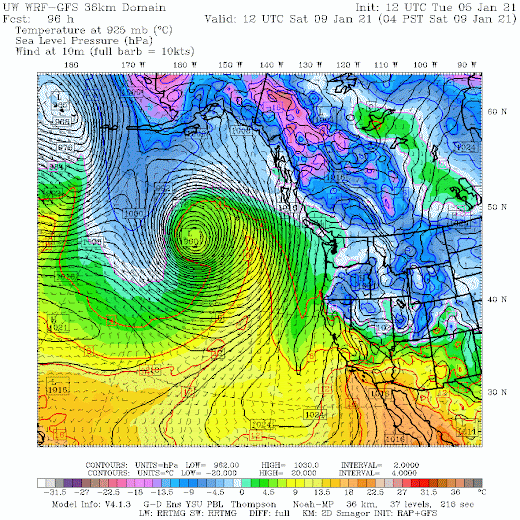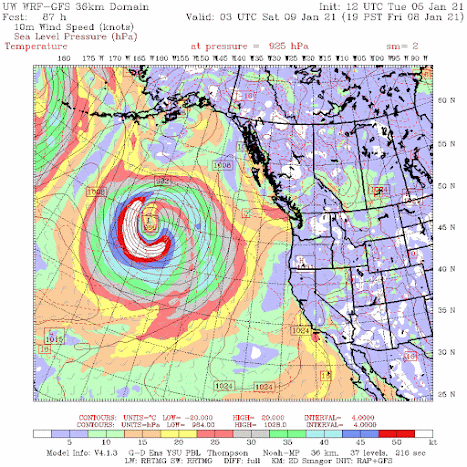The north Pacific Ocean will never experience a hurricane: a tropical storm with a sustained wind speed of 74 mph or more.
They aren't called hurricanes not because north Pacific storms aren't as strong or stronger than many hurricanes, but because they are not tropical in character.
Clouds swirl into a very deep low pressure center south of Alaska.
During the past few weeks, a number of extraordinarily intense north Pacific storms have formed, with several them putting most tropical hurricanes to shame. And a major Pacific storm will develop west of our coast later this week, producing huge waves and swell.
Consider the NOAA Ocean Prediction Center sea level pressure analysis for 10 AM PDT 31 December 2020. A low center near the southwest portion of the Aleutians had a central pressure of 921 hPa (mb), which is unbelievable. The DEEPEST LOW PRESSURE ON RECORD IN THE BERING SEA. It was the strongest storm to ever hit Alaska.
How does the low pressure of this storm compare to hurricanes? Consider the Saffir-Simpson hurricane categories often described by the media. The pacific storm near the Aleutians that day had a central pressure at the boundary between a Category 4 and Category 5 hurricane. And the associated winds greatly exceeded the requirements for a hurricane. ANOTHER low center (cyclone) to its east (west of our shores!) had a central pressure of only 972, similar to a category 2 hurricane.
And consider this: Hurricane Andrew, which brought catastrophic damage to southeastern Florida in 1992, had a central pressure of 922 hPa (mb)) and was a Category 5 storm, and Category 5 Hurricane Charley made landfall in Punta Gorda, Florida, in 2004 with a central pressure of 941 hPa. Hurricane Katrina at 920 hPa caused widespread devastation along many highly populated areas of the central Gulf Coast and had the third lowest central pressure ever recorded in that area.
And there is something else: north Pacific storms are much larger in size that tropical hurricanes. To demonstrate, here are images of the December 31 North Pacific Storm and Hurricane Laura (Cat. 4), using the same horizontal scales. Two to three times as large.
Hurricanes get their energy predominantly from the heat of evaporated water, which is released as latent heat in the storm as massive amounts of water condenses. Thus, hurricanes require warm water (above about 80F) to survive. North Pacific storms secure their energy from differences in temperature between the Arctic and subropics.
Another strong Pacific "hurricane" is predicted to form a thousand miles west of us on Friday/Saturday, with a low center of 960 hPa. Just slightly weaker than the great Columbus Day Storm of 1962.
The sustained winds at that time (see below) indicated a large area above 55 knots (63 mph) and surely the strongest winds will exceed hurricane strength
And don't worry about it hitting Washington State: it will swing northward into the Gulf of Alaska and eventually weaken. But the storm will produce HUGE waves, reaching 40-50 ft (significant wave height, see forecast for Saturday) and some of those will reach our shores on Sunday (see forecast graphic), although considerable attenuated (perhaps 30 ft).









I've seen recent news headlines about a "split polar vortex" and I'd love to hear more in a future weather blog.
ReplyDeleteagreed!
DeleteCliff I have heard that there is such a thing as a "polar hurricane". Does that mean one of these midlatitude storms you mention or is it a storm which gets it's energy from temperature differences in the vertical, just not as warm at sea-level as a tropical hurricane, but still unstable, relative to the temperature aloft?
ReplyDeleteCliff, is there a site we can monitor for wave height? We’d love to go out to the coast to watch.
ReplyDeletewindy.com
Deletehttps://www.chateauwestport.com/live-web-cam?fbclid=IwAR17oXbI2mzwmh8cqGwqwJuvFNRoby7RMLB0wGPnmCds64tR3uY8rhvKv8k
DeleteHere's a slightly better analogy for your Brownshirt theories Cliff
ReplyDeletehttps://www.huffingtonpost.ca/entry/trump-mob-violence-fascist-playbook_n_5ff64f8cc5b6ef6b158317d5?ri18n=true
Bruce....what happened yesterday was a national tragedy. But it did not happen in isolation. All political violence is wrong. Violence leads to violence. And the riots and violence of this summer...supported by some on the left...provided both the precedence and example that led to what happened yesterday. That was the essence of my blog...that political violence is wrong and violence on one side will destabilize society and lead to more violence...It appears that you did not understand what I was saying. ..cliff
DeleteAddendum: and just so you better understand the brownshirt analogy. The brownshirts were violent folks that were used as a tool by some in power or wishing to gain more power (the Nazis). The violent rioters were allowed to continue by some in power this summer. That is the similarity I was pointing out. And the continued violence supported or allowed provided an example of violence and provoked fear in others, leading to violence on the other side. You and others should consider this when you support violent individuals.
Delete"And the riots and violence of this summer...supported by some on the left...provided both the precedence and example that led to what happened yesterday."
DeleteNonsense.
MAC--why nonsense? My view is ALL political violence is bad and undermines the foundations of our democracy. Political violence by one group greatly encourages violence by other other groups. Surely you know this. I got a lot of heat for opposing the destruction and violence of the violence from folks like yourself, who believe that violence for your causes and ideas is somehow ok. It is not.
DeleteCliff, your analogy has some serious problems. For starters, the use of the word ‘violence’ is much to broad. Most of the violence in Seattle was directed at buildings and property - vandalism/arson. The brownshirts took things a bit further:
Delete“Hitler’s SA, or Brownshirts, played an important role in his rise to power. Formed and led by Ernst Röhm, they were modelled on Italy’s Blackshirts and engaged in violent acts against Jewish people, trade unionists and others. When Hitler came to power in 1933. they set up mini concentration camps in cinemas and docks to
incarcerate “enemies”.”
The Seattle protestors burned buildings.
The SA burned human beings. And yet the analogy paints them as essential equal:
“The brownshirts were violent folks.... “
“The violent rioters.... “
An egregious false equivalency.
Cliff -
Delete“Violence leads to violence. And the riots and violence of this summer...supported by some on the left...provided both the precedence and example that led to what happened yesterday.”
An earlier precedent:
“In 1925 the Ku Klux Klan (KKK) marched down Pennsylvania Avenue in Washington, DC. The organized event brought 25,000 members in full regalia to the city. Demonstrating at the height of their power, the KKK was a national fraternal organization founded on the premise of white supremacy. The KKK attacked the social and political rights of African Americans, immigrants, Catholics, and Jews. First founded in 1865, the power of the Klan peaked during the 1920s when urbanization, industrialization, and immigration frightened many Americans.”
http://mallhistory.org/items/show/175
What next Cliff? Will you be blaming Wednesday's attacks on Antifa?
DeleteMac.... that is silly. There is no evidence that Antifa played a role in the DC riot. Don't you know that?...cliff
DeleteSnape.... please read the history of the pre-war period. The analog is powerful...and even more so after the events of last week. Political violence destabilizes societies and the Nazi use of violence was key to undermining the Weimar Republic. And you should know that a number of people died as a result of the events of this summer, including two in Chaz here in Seattle. When I wrote my blog I was very worried that allowing violence as a new norm of political expression would undermine our democracy. You saw it happen last week.
DeleteAnd regarding the KKK, did you know what party was closely aligned with them? Hint: it was not the Republican party...cliff
So we have Mac, Snape, and Bruce Kay in favor of communist violence. Typical Seattle.
Delete“When I wrote my blog I was very worried that allowing violence as a new norm of political expression would undermine our democracy. You saw it happen last week.”
Delete“Allowing violence“?
Be specific, Cliff. Last spring/summer I saw thousands of protesters around the US being sprayed with tear gas and rubber bullets. Thousands of arrests as well.
I agree with you that the government response to what happened in Seattle was unacceptable, but are you asserting that had the response been appropriate, the siege on our Capital would never have occurred?
A spurious claim at best, IMHO
Snape... I believe you are wrong. The violence of this summer "normalized" the use of political violence. Violence begets violence. Political violence begets political violence. Even a superficial reading of history provides bountiful examples of this. I strongly believe that the tragic violence in the Capitol this week would not have happened if ALL of us stood up against political violence...cliff
DeleteCareful not to turn an idea like ‘violence begets violence’ into a law or forcing, where people no longer have free will.
DeleteA man on trial for rape could argue that had his victim worn less revealing clothes, he never would have noticed her and therefore nothing would have happened. Even if true, it‘s a ploy to deflect blame away from the perpetrator and onto someone else.
This is similar to what your argument does WRT the Capital mob - deflects responsibility for their actions. As if they had no choice in the matter.
BTW, I appreciate that you’ve let me share my opinion, even if very different than yours.
We shall call them northicanes. I hate the waves. Been building gabion defences on the beach for a year now
ReplyDeleteMe too! I would love to learn more about the split polar vortex. Good question.
ReplyDeleteSudden stratospheric warming (SSW) event explanation as associated with PNW.
ReplyDeleteI really appreciate this explanation of "our" type of storms...It is mind-bending, to think of any type of storm registering a pressure of 921!...the awesome 1962 storm I lived through in Seattle, registered 956...I cannot imagine experiencing a storm with such intensity!!
ReplyDeleteYou wrote:
ReplyDelete"Thus, hurricanes require warm water (above about 80F) to survive. North Pacific storms secure their energy from differences in temperature between the Arctic and subropics."
I'd like to have an explanation for the mechanics of that temperature difference, especially the influence of the far-away tropics.
Middle lattitude cyclones have weaker winds than hurricanes because the pressure difference is spread over a larger area and middle lattitude cyclones lack strong eyewall thunderstorms that mix strong winds down to the surface. Its not completely accurate to say that a 960 milibar middle lattitude cyclone is equivalent to a catagory 3 hurricane the middle lattitude cyclone will have storm force or cat 1 winds but will affect a bigger area than the hurricane. The strongest middle lattitude cyclone I have seen had 100 knot winds over water and much weaker winds over land. This is equivalent to a high end cat 2/low end cat 3 hurricane. Occasionally a modest middle lattitude cyclone 960-970 milibars produces as strong of a winds as a 940 milibar middle latitude cyclone. I'm not sure why this is but I suspect that a modest middle lattitude cyclone can have a suprisingly high windspeed if its rapidly strengthening, moving quickly and has a powerful jet stream behind it.
ReplyDeleteInteresting reply, and makes sense. From what I've read, those outlandishly high hurricane winds quoted by reporters are seen at the eyewall and don't go all that far from the center. So, for example, a "category 4" hurricane might have 150 mph winds near the center but weaker winds 30 or 40 miles out. Maybe not that far; I don't know enough to say.
DeleteI wonder if two storms with the same pressure, one a hurricane and the other a "middle latitude cyclone," would have similarly strong winds if the eyewall winds of the hurricane were removed from the comparison and the comparison were instead drawn between winds observed away from the storm centers.